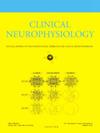Patterns of ictal surface EEG in occipital seizures: A simultaneous scalp and intracerebral recording study
IF 3.7
3区 医学
Q1 CLINICAL NEUROLOGY
引用次数: 0
Abstract
Objective
To describe the ictal scalp EEG patterns of occipital seizures (OS) and their spatiotemporal correlations with intracerebral occipital ictal discharges derived from simultaneous SEEG-EEG recordings.
Methods
Patients with SEEG confirmed OS (14 OS from 8 patients) were selected from an epilepsy surgery center and were monitored 3–10 days using simultaneous scalp EEG and SEEG recordings.
Results
On scalp EEG, the most common onset patterns were background activity suppression (28.6 %) and high amplitude slow wave corresponding to intracerebral DC-shift (28.6 %) and occurred with a median delay of 0 s after intra-cerebral onset. The initial discharge involved occipital electrodes in only 50 % of the seizures (7/14) with additional basal temporal (8/14) or parietal electrodes (5/14). The onset was ipsilateral to the intra-cerebral onset zone in 71.4 % of seizures and bilateral in the remaining (28.6 %). The most common propagation pattern was either unilateral (50 %) or bilateral (50 %) and a rhythmic slow activity (66.7 %). Different OS subtypes display distinct scalp EEG patterns.
Conclusion
Scalp EEG accurately determines intra-cerebral seizure onset time in OS and has good lateralizing value. However, initial scalp modification does not always involves occipital electrodes and the second modification is well lateralizing in only 50 % of seizures.
Significance
This study describes will help clinicians to better identify OS during video EEG and better plan intra-cerebral explorations for epilepsy surgery.
枕叶癫痫发作时的发作表面脑电图模式:头皮和脑内同步记录研究
方法从癫痫外科中心选取经 SEEG 确认的 OS 患者(8 例患者中的 14 例 OS),使用头皮脑电图和 SEEG 同步记录对其进行 3-10 天的监测。结果 在头皮脑电图上,最常见的发病模式是背景活动抑制(28.6%)和与脑内直流偏移相对应的高幅慢波(28.6%),脑内发病后的中位延迟时间为 0 秒。只有 50% 的癫痫发作(7/14)的初始放电涉及枕部电极,另有颞叶基底电极(8/14)或顶叶电极(5/14)。在 71.4% 的癫痫发作中,起始点位于大脑内起始区的同侧,其余(28.6%)为双侧。最常见的传播模式是单侧(50%)或双侧(50%)和节律性缓慢活动(66.7%)。结论头皮脑电图能准确判断 OS 的脑内发作起始时间,并具有良好的侧位价值。本研究有助于临床医生在视频脑电图中更好地识别 OS,并更好地规划癫痫手术的脑内探查。
本文章由计算机程序翻译,如有差异,请以英文原文为准。
求助全文
约1分钟内获得全文
求助全文
来源期刊

Clinical Neurophysiology
医学-临床神经学
CiteScore
8.70
自引率
6.40%
发文量
932
审稿时长
59 days
期刊介绍:
As of January 1999, The journal Electroencephalography and Clinical Neurophysiology, and its two sections Electromyography and Motor Control and Evoked Potentials have amalgamated to become this journal - Clinical Neurophysiology.
Clinical Neurophysiology is the official journal of the International Federation of Clinical Neurophysiology, the Brazilian Society of Clinical Neurophysiology, the Czech Society of Clinical Neurophysiology, the Italian Clinical Neurophysiology Society and the International Society of Intraoperative Neurophysiology.The journal is dedicated to fostering research and disseminating information on all aspects of both normal and abnormal functioning of the nervous system. The key aim of the publication is to disseminate scholarly reports on the pathophysiology underlying diseases of the central and peripheral nervous system of human patients. Clinical trials that use neurophysiological measures to document change are encouraged, as are manuscripts reporting data on integrated neuroimaging of central nervous function including, but not limited to, functional MRI, MEG, EEG, PET and other neuroimaging modalities.
 求助内容:
求助内容: 应助结果提醒方式:
应助结果提醒方式:


